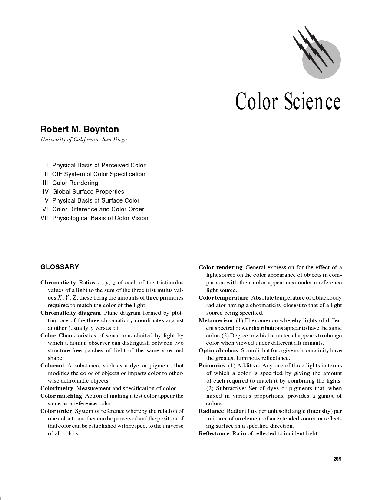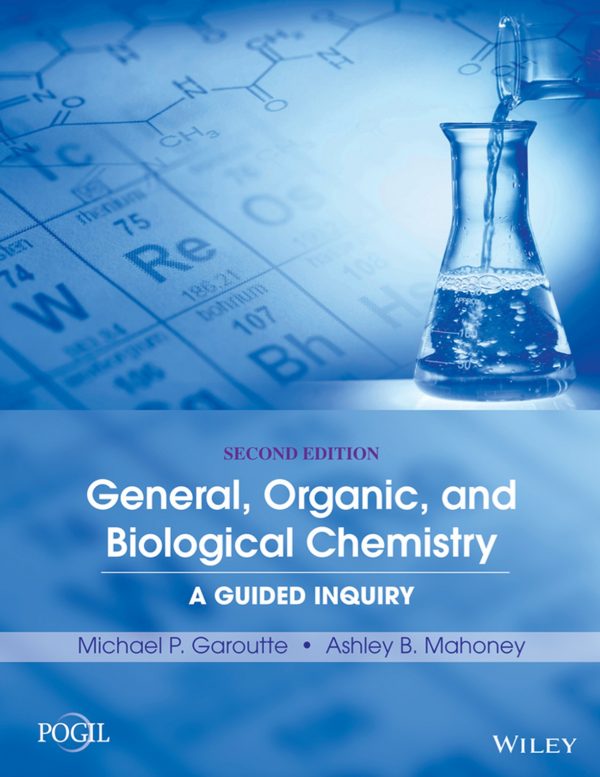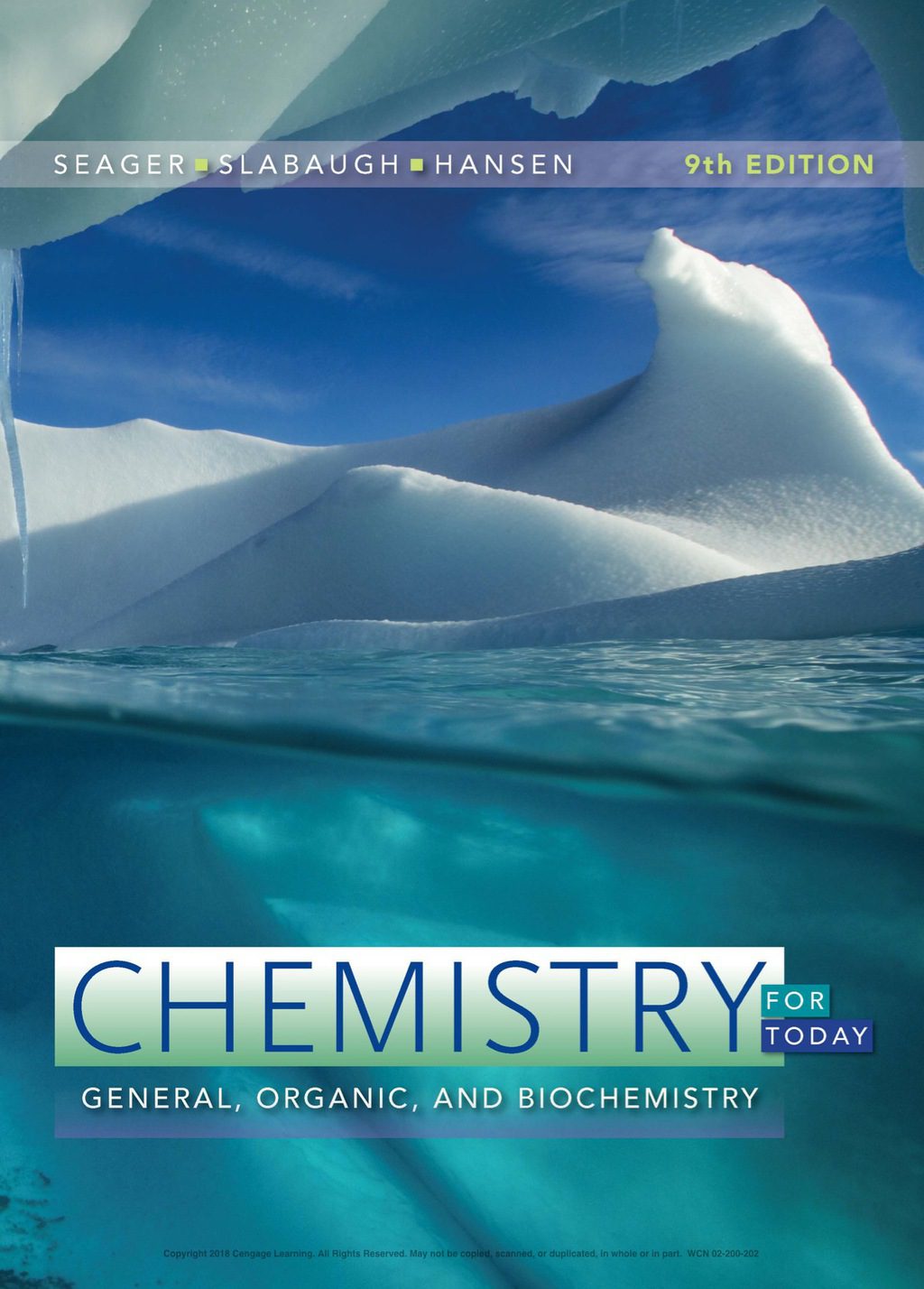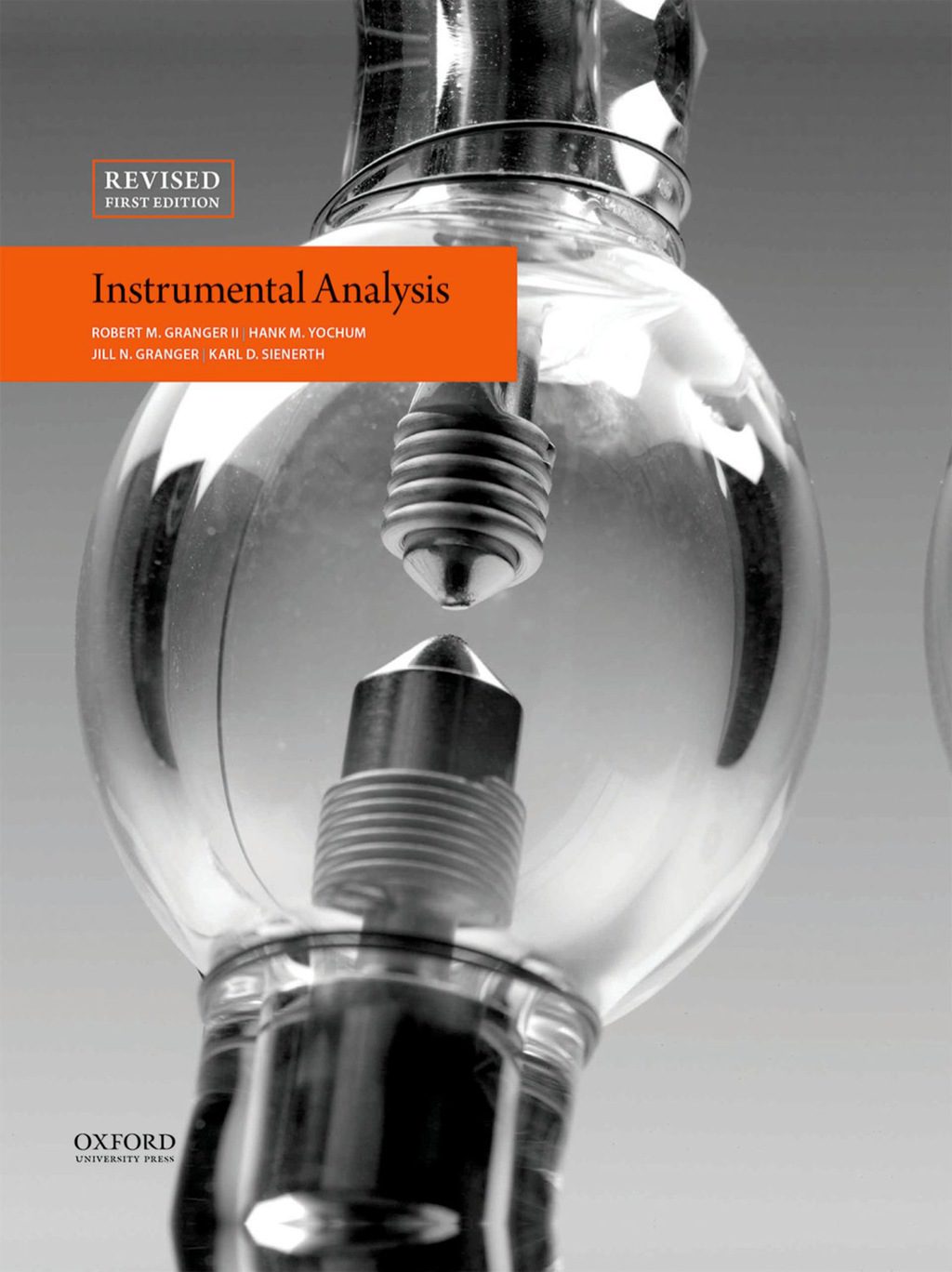Robert A. Meyers (Editor-in-Chief)
Table of contents :
Glossary……Page 1
Basic Color-Matching Experiment……Page 2
Imaginary Primaries……Page 3
Chromaticity Diagram……Page 4
Best and Worst Artificial Sources for Color Rendering……Page 6
Correlated Color Temperature……Page 7
Color-Rendering Index……Page 9
Specular and Diffuse Reflectance……Page 10
Measuring Diffuse Surface Reflectance……Page 11
Chromaticity of an Object……Page 12
Fluorescence……Page 14
Metamerism Index……Page 15
Color from Organic Molecules……Page 16
Other Causes of Spectrally Selective Reflection……Page 17
Color Difference and Color Order……Page 18
Color-Difference Data……Page 20
CIELUV Color Difference Formulas……Page 21
Arrangement of Colors……Page 22
Physiological Basis of Color Vision……Page 23
References……Page 25
History of Critical Data Programs……Page 26
International Activities……Page 27
Methods of Evaluating Data……Page 28
Dissemination of Critical Data……Page 33
References……Page 37
Glossary……Page 38
Temperature……Page 39
Quantum Statistics……Page 40
Insulators……Page 42
Metals……Page 44
Liquid 4He and Liquid 3He……Page 45
Superfluid Properties of Liquid 4He……Page 46
Normal Liquid 3He……Page 51
Superfluid Properties of Liquid 3He……Page 52
Evaporation Cryostats……Page 54
Helium Dilution Refrigerators……Page 55
Pomeranchuk Refrigeration……Page 56
Magnetic Cooling……Page 57
Thermometry……Page 58
Cryogenic Applications……Page 59
References……Page 60
Glossary……Page 61
Standards and Absolute Measurements……Page 62
Substitution……Page 63
Analog Techniques……Page 64
Digital Measurements……Page 66
External Influences……Page 68
Determination Error……Page 70
Loading or Insertion Error……Page 71
Voltages……Page 72
Currents……Page 76
Power Measurement……Page 78
Resistance Measurement……Page 80
Capacitance and Inductance……Page 81
Waveform Monitoring……Page 83
Waveform Recording……Page 87
Digital Frequency and Time Measurements……Page 89
Spectrum Analysis……Page 91
Resistance Change……Page 92
Reactance Change……Page 93
Signal Transmission……Page 94
Recording and Monitoring Methods……Page 95
Automated Test Equipment……Page 96
References……Page 97
Principles of Flow Visualization Techniques……Page 98
Flow Visualization by Tracer Material……Page 99
Visualization by Refractive Index Changes……Page 101
Thermal Interaction……Page 103
References……Page 104
Glossary……Page 105
Brief History of Geodesy……Page 106
Geodesy and Other Disciplines and Sciences……Page 107
Coordinate Systems Used in Geodesy……Page 108
Point Positioning……Page 109
Relative Positioning……Page 110
Treatment of Errors in Positions……Page 112
Coordinate Transformations……Page 114
Origin of the Earth’s Gravity Field……Page 115
Gravity Potential……Page 117
Magnitude of Gravity……Page 118
Direction of Gravity……Page 119
Transformations between Field Parameters……Page 120
Stokes’s Geodetic Boundary Value Problem……Page 121
Molodenskij’s Geodetic Boundary Value Problem……Page 122
Temporal Changes in Coordinate Systems……Page 123
Temporal Changes in Positions……Page 124
Satellite Motion, Functions, and Sensors……Page 126
Satellite Positioning……Page 127
Gravitational Field Studies by Satellites……Page 129
References……Page 130
Glossary……Page 131
Declustering……Page 132
Variogram Modeling……Page 133
Simple Kriging……Page 134
Sequential Gaussian Simulation……Page 135
Indicator Methods……Page 136
Environmental……Page 137
Petroleum……Page 138
References……Page 141
Definition of the Global Gravity Field……Page 142
Method of Measurement……Page 144
Applications……Page 146
References……Page 148
Glossary……Page 149
Stereomicroscope……Page 150
Spectrometers……Page 151
Transmission Electron Microscope……Page 152
X-ray Spectroscopy……Page 153
Significance of Polarized Light Microscopy to Chemical Microscopy……Page 154
Observable Optical Phenomena……Page 155
Microchemical Tests……Page 157
See also the Following Articles……Page 158
References……Page 159
Glossary……Page 160
Absolute Measurements of Length……Page 161
Optical Testing……Page 162
Tests of Aspheric Surfaces……Page 163
Interference Microscopy……Page 164
Stellar Interferometers……Page 165
Gravitational-Wave Interferometers……Page 166
Phase-Conjugate Interferometers and Squeezed Light……Page 167
References……Page 168
Glossary……Page 169
Basic Principles……Page 170
Secular Variation Effects……Page 171
Recent Anthropogenic 14C Effects……Page 173
Accelerator Mass Spectrometry Direct or Ion Counting……Page 174
References……Page 175
History of Development of Radiometric Dating Methods……Page 176
Principles of Radiometric Dating……Page 177
The K–Ar Method……Page 178
The 40Ar/39Ar Method……Page 179
The Rb–Sr Method……Page 180
The Sm–Nd, Lu–Hf, and Re–Os Methods……Page 181
The U, Th, Pb Methods……Page 182
The Radiocarbon Method……Page 183
Accuracy of Radiometric Dating……Page 184
References……Page 185
Glossary……Page 186
Choice of Pharmaceutical……Page 187
Gamma Camera……Page 188
Tomography……Page 190
Quantitation……Page 191
Instrumentation……Page 192
References……Page 194
History……Page 195
Electron–Optical Performance……Page 196
Major Electron–Solid Interactions……Page 197
Secondary Electrons……Page 198
Voltage Contrast……Page 199
Magnetic Contrast……Page 200
Atomic Number Contrast……Page 201
Electron Beam–Induced Currents……Page 202
Fluorescent X Rays……Page 203
Cathodoluminescence……Page 204
References……Page 205
Glossary……Page 206
Astronomical Seeing and Resolution……Page 207
Speckle Camera Requirements and Technology……Page 208
Application to High-Resolution Imaging……Page 209
Stellar Angular Diameters……Page 211
The Future of High-Resolution Astronomy……Page 212
References……Page 213
Glossary……Page 214
Thermodynamic Basis……Page 215
Oxygen Isotopic Composition of the Oceanic Crust……Page 217
Oxygen Isotopic Composition of the Continental Crust……Page 218
Processes Affecting the Oxygen Isotopic Composition of Igneous Rocks……Page 220
Controls on the Oxygen Isotope Composition of Seawater……Page 221
Meteoric Water Cycle……Page 223
Subsurface Fluids……Page 224
Carbon in the Lithosphere……Page 226
Long-Term Coupled Carbon–Sulfur Isotope Variations……Page 227
The Marine Record: Tertiary and Quaternary Oxygen Isotopes……Page 229
Geologic Variation……Page 230
Anthropogenic Forcing……Page 231
References……Page 232
Glossary……Page 234
Macroscopic State of Classical Systems……Page 235
Macroscopic State of Quantum Systems……Page 236
Classical Systems……Page 239
Classical Systems……Page 240
Quantum Systems……Page 241
Classical Systems……Page 242
Quantum Systems……Page 243
Classical Systems……Page 244
Quantum Systems……Page 245
Isomorphism between Information Theory and Statistical Mechanics……Page 246
Classical Version……Page 247
Statistical Mechanical Basis for Equilibrium Thermodynamics……Page 249
Classical Systems……Page 253
Quantum Systems……Page 255
Phenomenological Equations of Motion……Page 257
Classical Brownian Motion Theory……Page 259
Nonequilibrium Thermodynamics (Phenomenological Theory of Irreversible Processes)……Page 262
Continuous Systems……Page 263
Discrete Composite Systems……Page 265
Statistical Mechanical Basis for Nonequilibrium Thermodynamics……Page 266
Spatially Independent Thermodynamic Coordinates……Page 267
Spatially Dependent Thermodynamic Coordinates……Page 273
Spatially Independent Properties……Page 277
Spatially Dependent Properties……Page 280
Response to External Disturbances……Page 281
Mori–Zwanzig Projection Operator Formalism……Page 284
Maximum Entropy Approach to Nonequilibrium Processes……Page 286
Spatially Independent Thermodynamic Coordinates……Page 287
Spatially Dependent Thermodynamic Coordinates……Page 290
Dual Lanczos Transformation Theory……Page 293
Evolution of Dynamical Vectors……Page 294
Decomposition of System Dynamics……Page 295
Dual Lanczos Transformations……Page 296
Projected Transition Operators and Generalized Polynomials……Page 297
Extraction and Utilization of Dynamically Embedded Information……Page 298
Memory Function Hierarchies, Continued Fractions, and Pad´e Approximants……Page 302
References……Page 303
Introduction……Page 305
International Standardization……Page 306
Standards for General and Scientific Use……Page 307
Standards for Industrial Use……Page 308
Future Directions……Page 310
References……Page 311
Glossary……Page 312
Stability……Page 313
Equivalent Dose Determination……Page 314
Annual Radiation Dose……Page 315
Authenticity Testing……Page 316
References……Page 317
Concepts and History……Page 318
The Evolution of Time and Frequency Standards……Page 319
Time Scales and the International Definition of the Second……Page 321
Accuracy……Page 322
Uncertainty Analysis……Page 323
Time and Frequency Standards……Page 326
Quartz Oscillators……Page 327
Cesium Oscillators……Page 328
Hydrogen Masers……Page 329
Time and Frequency Transfer……Page 330
Common-View Method……Page 331
HF Radio Signals (IncludingWWVand WWVH)……Page 332
LF Radio Signals (Including WWVB)……Page 333
GPS common-view measurements…….Page 334
Telephone Time Signals……Page 335
References……Page 336
Glossary……Page 337
More Complex Systems……Page 338
Wave Equation……Page 339
Transducer Beams……Page 340
Attenuation……Page 341
Sonar Equation……Page 342
Common Transducers……Page 343
Pulsed methods……Page 344
Common Ways of Using Pulsed-Ultrasound……Page 345
Sources of High Power CW Ultrasound……Page 347
Stringed Instruments……Page 348
Electronic Instruments and Composition……Page 349
Transducer Arrays……Page 350
Medical Ultrasonics……Page 351
Acoustic Emission……Page 352
Marine Sonar and Sonar in Animals……Page 353
Processing Technology……Page 354
References……Page 355
Glossary……Page 356
General Description of the Vacuum Arc……Page 357
Arc Ignition……Page 358
Cathode Spots……Page 359
Interelectrode Phenomena……Page 360
Arc Stability……Page 361
High-Power Vacuum Interrupter……Page 363
Triggered Vacuum Gap……Page 365
Vacuum Fuse……Page 366
References……Page 367







Reviews
There are no reviews yet.